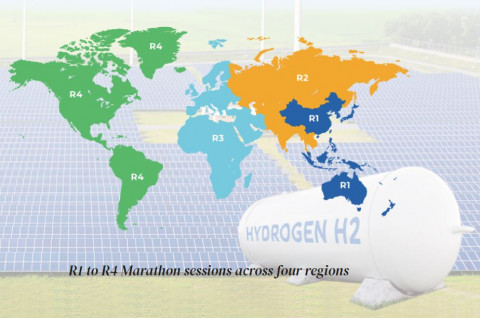IIT researchers crack CO2-to-CO method that could help decarbonize industry
India has granted researchers at IIT Bombay a patent for technology that converts CO2 into CO or carbon monoxide, in a process that holds huge potential for carbon capture and energy savings in the industry sector, especially steel making.
Carbon monoxide (CO) is widely used in industrial applications, especially in the form of syngas. In the steel industry, CO is an essential ingredient for converting iron ores to metallic iron in blast furnaces. However, the current industrial process for converting CO2 to CO is extremely energy-intensive, requiring high temperatures (400-750 degrees C) and the presence of an equivalent amount of hydrogen for driving the reaction forward.
The manufacturing of CO itself is harmful. At present, the industry produces CO through partial oxidation of coke or coal, which creates a significant amount of CO2 as end product. By capturing this CO2 and converting it into CO, the IIT researchers are hoping to create a circular process that would also substantially reduce industrial carbon footprints.
The new process is based on an electrocatalysis reaction that requires minimal energy and can proceed under ambient temperatures in the presence of water. Additionally, the required energy can be directly harnessed from a renewable source such as a solar panel or a wind mill, allowing the process to operate in a carbon-neutral manner.
The process was discovered by researchers led by Dr. Arnab Dutta and Dr. Vikram Vishal at the National Centre of Excellence in Carbon Capture and Utilisation (NCoE-CCU), part of IIT Bombay. Their innovation has also been accepted for publication in Nature Communications.
In their paper, the authors point out that developing sustainable technology "for facile CO2 to CO conversion can unlock new opportunities in the CCUS vertical of decarbonization while paving a sustainable CO2 utilization pathway,"
"CO, a reactive chemical typically generated from partial oxidation of coke, is one of the highly sought vital reagents for large-scale industrial processes such as the Fischer-Tropsch synthesis of hydrocarbons, the Monsanto/ Cativa acetic acid synthesis, iron oxide reduction in blast furnaces, and methanol synthesis from syngas," states the paper, which is available for reading under open access norms here.

Eye on EV Charging: India is driven by smaller vehicles, battery swapping draws big interest
INDIA'S CARBON CAPTURE CENTERS
The NCoE-CCU at IIT Bombay, supported by the Department of Science and Technology, is one of two national centers for carbon capture, the other being the National Centre in Carbon Capture and Utilization located at the Jawaharlal Nehru Centre for Advanced Scientific Research in Bengaluru.
The centres have been set up to assist in the development of an appropriate and feasible R&D and innovation roadmap. The centres are also collectively tasked with keeping track of international trends and developments and suggesting possibilities for collaboration with foreign governments or research agencies.
The NCoE-CCU at IIT Bombay was inaugurated by Dr. Vijay Kumar Saraswat, member, NITI Aayog, on February 11, 2023. The center is tasked with defining milestones and spearheading science and technology initiatives for industry-oriented CCU innovation in India, alongside developing novel methodologies for improving the technology readiness levels in CCU. It also looks at accelerating R&D efforts in methods of carbon capture and utilization.
The centre at Mumbai also works on conversion of captured CO2 to chemicals, CO2 transport, compression and utilization, as well as on enhanced hydrocarbon recovery as co-benefit pathways. It is also involved in development and demonstration of efficient CO2 capture from representative flue gas from the effluents of power plants and biogas plants.
The NCCCU at JNCASR aims to develop and demonstrate carbon capture and conversion by developing relevant materials and methodologies. These processes will then be scaled up to pilot scale mode to produce hydrocarbons, olefines and other value-added chemicals and fuels.
The center also works on reaching technology readiness level that match industry requirements for commercial purpose. The centre also promotes CCU research, provides training and consultancy and translates its research excellence into solutions with global economic and social impact.
GLOBAL DECARBONIZATION DRIVE
The global industrial sector has been looking at new technologies that allow them to decarbonize operations as the world moves towards the net zero emissions. Here are some sector wise updates:
- The building sector requires major innovations in carbon reduction technologies. Globally, the building and construction value chain accounts for about 40 percent of energy and industrial-related CO2 emissions. In a recent report, the World Bank's lending arm IFC estimated the developing world needs $1.5 trillion to remake existing buildings into environmentally friendly structures and improve construction processes. About $1.33 trillion of the money is required for China alone. The building sector also needs to switch towards large-scale centralized cooling, sometimes known as district cooling, and consider changes to the make building products are manufactured.
- Steelmaking is among the world's most polluting industries, estimated to be responsible for about 11 percent of global carbon emissions. Steelmakers from India's Tata Steel and Japan's Hitachi to Germany's ThyssenKrup have been testing new technologies such as hydrogen-gas fueled blast furnaces, carbon capture to develop syngas from outgoing CO2, and increasing electrification or digitization of manufacturing processes. Steel companies are also looking at hydrogen-powered vessels to reduce emissions from transport of raw materials.
- The shipping sector has been evaluating alternative fuels such as green methanol and biofuels from vegetable oil as well as ships powered by large sails that can harness the wind. The sector accounts for about three percent of global greenhouse gas emissions.
- Aviation accounts for two-three percent of global carbon emissions and the industry has announced plans to become net zero by 2050. Towards this, several carriers are slowly replacing aviation turbine fuel with the alternative sustainable aviation fuel and other biofuels. Some companies are testing hydrogen-fueled aircraft, while others are evaluating smaller planes powered by batteries.
- The fossil fuel sector is under pressure because of the carbon emissions it lets out while making the very products held responsible for carbon emissions. In response, some oil companies have outlined plans to foray into clean energy operations, although the sector as a whole is considered to be lagging. Western oil companies have been buying carbon capture companies outright -- Exxon bought Denbury and Oxy acquired Carbon Engineering -- while Middle Eastern giants such as Aramco and ADNOC are partnering with third parties to implement carbon capture technologies. Earlier this year, Asia's largest carbon-capture project turned operational at a coal plant in China.
- One simple, often forgotten method to decarbonize is increasing efficiency. The Energy Efficiency Movement estimates factories around the world could reduce four gigatons of carbon emissions annually from 2030 – equal to removing 60 percent of the world's petrol and diesel-powered vehicles from roads -- if they implemented regular energy audits, deployed more efficient engines and undertook other measures to improve energy synergy.















